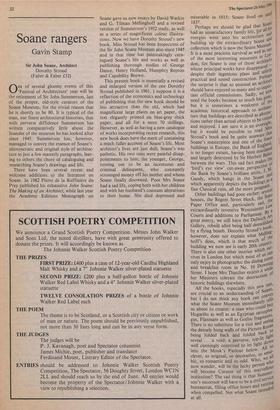Soane rangers
Gavin Stamp
Sir John Soane, Architect Dorothy Stroud (Faber & Faber £32)
One of several gloomy events of this 'Festival of Architecture' year will be the retirement of Sir John Summerson, last of the proper, old-style curators of the Soane Museum, for the trivial reason that he is shortly to be 80. It is typical of the man, our finest architectural historian, that with perverse diffidence Summerson has written comparatively little about the founder of the museum he has looked after since 1945. Summerson has, however, managed to convey the essence of Soane's idiosyncratic and original style of architec- ture in just a few masterly paragraphs, leav- ing to others the chore of cataloguing and researching Soane's drawings and life.
There have been several recent and welcome additions to the literature on Soane. In 1982 Pierre de la Ruffiniere du Prey published his exhaustive John Soane: The Making of an Architect, while last year the Academy Editions Monograph on
Soane gave us new essays by David Watkin and G. Tilman Mellinghoff and a revised version of Summerson's 1952 study, as well as a series of magnificent colour illustra- tions. Now we have Dorothy Stroud's new book. Miss Stroud has been Inspectress of the Sir John Soane Museum also since 1945 and in that time has painstakingly cata- logued Soane's life and works as well as publishing thorough studies of George Dance, Henry Holland, Humphry Repton and Capability Brown.
This present book is essentially a revised and enlarged version of the one Dorothy Stroud published in 1961. I suppose it is a reflection of the economics and technology of publishing that the new book should be less attractive than the old, which had magnificent large plates on art paper, the text elegantly printed on blue-grey thick paper, and all for a mere 70 shillings. However, as well as having a new catalogue of works incorporating recent research, this new book does have the merit of containing a much fuller account of Soane'S life. Most architect's lives are just dull; Soane's was pathetic. His two sons were painful disap- pointments to him; the younger, George, turning out to be an incestuous and criminal delinquent, who constantly scrounged money off his mother and whom Soane finally disowned. Poor Mrs Soane had a sad life, coping both with her children and with her husband's constant alterations to their home. She died depressed and
The Spectator lived260MnaYtil: 1837. miserable in 1815; Soane Perhaps we should be glad that Soane had an unsatisfactory family life, for all energies went into his architecture and building up the extraordinary house all collection which is now the Soane Museum- It is a most precious survival as well 4s one of the most interesting museums in 1-°/1- don, for Soane is one of those architects whose principal works have disappeared '— despite their ingenious plans and utterlY Stroud's book and be quite unaware that Perhaps, practical and sound construction. the surprise is that so unusual an architec should have enjoyed so many and so ityPor- tant official commissions. Sadly, we acip‘s need the books because so much has g°11,e. but it is sometimes a weakness of the academic historical approach to archilec" ture that buildings are described as abstraecic- lions rather than actual objects to be visit and enjoyed. I am sure it is an oversigh.t, but it would be possible to read Miss( Soane's masterpiece and one of the firlect buildings in Europe, the Bank of Englan is no longer extant, having been mutilate and largely destroyed by Sir Herbert Bakfe between the wars. This sad fact makes til 'bird's eye view' cut-away perspective t. the Bank by Soane's brilliant artist, J. Gandy, which hangs in the Soane as which apparently depicts the buildings as fine Classical ruin, all the more poignanta. Other buildings had gone earlier: $ever e houses, the Regent Street block, the Sta.te Paper Office and, particularly sad, extraordinarily inventive Westminster La; Courts and additions to Parliamenrt. BY t great mercy, we still have the Dulwich Ar„, Gallery, rebuilt after being half-demolisnekur by a flying bomb. Dorothy Stroud's b0° however, does not explain what Merriig; hoff's does, which is that much 0 ` l building we now see is early 20th century: There is also one other interior which su vives in London but which most of Us can — only enjoy in photographs: the dining room and breakfast room in No. 10 130wri,”:,(e Street. I hope Mrs Thatcher enjoys it f her Ministers tolerate the destruction ° historic buildings elsewhere. All the books, especially this new one, are crucial to an understanding of S°arle' but I do not think any book can co hells what the Soane Museum immediatelY te' us about its creator: a man who could buy Hogarths as well as an Egyptian sarcopha- gus, Flaxmans as well as Gothic frag-nlea,ts; There is no substitute for a visit and seell4" the densely hung walls of the Picture Ro°111, being folded back and folded back pt reveal ... a void: a perverse, top-lit litr, well cunningly contrived to let light d0., into the Monk's Parlour below. All s'" clever, so original, so decorative, so sensiii ble, so romantic and so odd. Who, we hao now wonder, will be the lucky person w" will become Curator of this marvellous institution? The sad thing is that Summer- son's successor will have to be a civil service bureaucrat, filling office hours and retiring. awtt aelEncompelled. Not what Soane intend














































 Previous page
Previous page